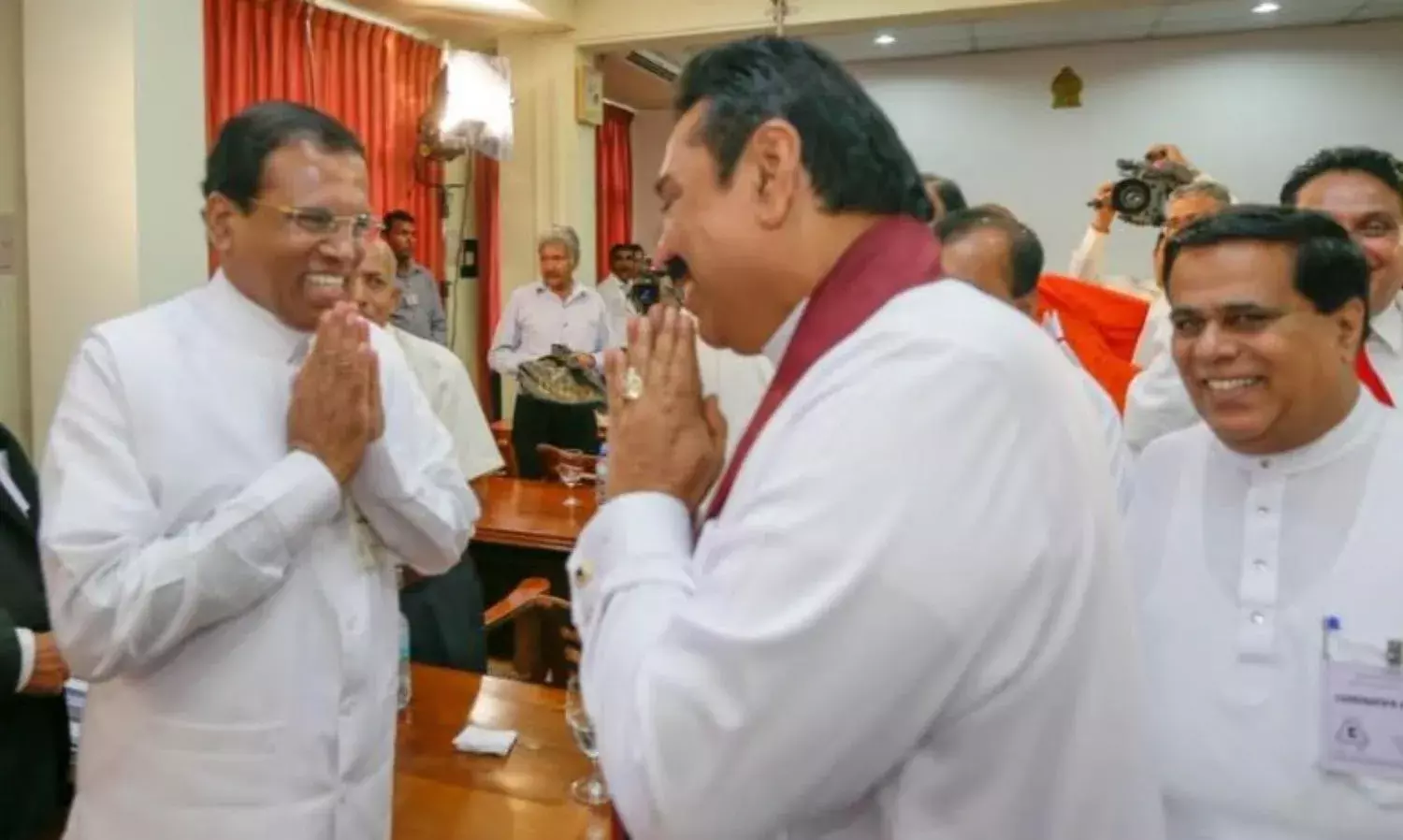Rajapaksa To Maintain “Friendly Relations” With Both China and India
Rajapaksa became PM at Sirisena’s request

COLOMBO: It was at the request of President Maithripala Sirisena, that former President Mahinda Rajapaksa took up the Premiership of Sri Lanka on Friday, sources close to Rajapaksa said.
Rajapaksa group decided to accept the offer when it found that the President was very keen,” the sources, which did not want to be identified, said.
Till a few days ago, Sirisena had been wavering. On the one hand, he was wanting to align with Rajapaksa to set up an United People’s Freedom Alliance (UPFA) government without any links with the United National Party (UNP) headed by Prime Minister Ranil Wickremesinghe.
But on the other hand, he was reluctant to accommodate Rajapaksa, his rival since 2015, when he had ditched Rajapaksa to become the candidate of the Wickremesinghe-led opposition in the Presidential election.
The choice for Sirisena thus between a rock and a hard place or the devil and the deep sea. He had serious issues with both.
One the one hand, he knew that Rajapaksa was bent on finishing his political career .But on the other hand, he was finding it impossible to work with Wickremesinghe because of differences in ideology, temperament and style of functioning.
While Sirisena was on the horns of a dilemma, the 16 MPs of the UPFA who had switched over to the opposition to work in unison with Rajapaksa’s Sri Lanka Podujana Peramuna (SLPP) and the Joint Opposition group, were pushing hard for leaving the UPFA-UNP coalition government; sacking Wickremesinghe; and installing Rajapaksa as Prime Minister.
Sirisena’s contradiction with Wickremesinghe grew to dangerous proportions over the alleged plot to assassinate him with the alleged backing of the Indian intelligence agency Research and Analysis Wing (RAW). Sirisena openly accused Wickremasinghe of being indifferent to the threat to his life from a foreign intelligence agency.
Sirisena decided to take the drastic step of pulling out of the coalition, sacking Wickramasinghe and appointing Rajapaksa as Prime Minister.
It is alleged that Rajapaksa had prepared the ground for this by playing up the issue of RAW’s alleged involvement in the alleged assassination attempt, to make Sirisena insecure vis-à-vis India.
As if the information already with Sirisena about the alleged assassination plot was not enough, Rajapaksa’s henchman, Wimal Weerawansa, called a press conference to say that the suspected RAW agent had met him, and had given him his identity number also. Weerawansa gave the man’s name and ID number fto the media.
With this incident bringing India and Wickremesinghe together, Sirisena’s alienation from Wickremesinghe and India was complete.
He had no option to accept the advice of the 16 dissident MPs and make a daring move to link up with Rajapaksa.
Discarding the practice of talking through intermediaries, Sirisena decided to talk to Rajapaksa one to one. It was at the one to one dialogue that the offer of Premiership was made to Rajapaksa by Sirisena. Rajapaksa accepted it with alacrity.
It was decided to keep it a top secret. No others, including influential foreign powers, got a clue about it. This was an entirely home made brew with no foreign ingredient in it, neither Indian nor Chinese, the sources remarked.
Asked how the Sirisena-Rajapaksa combine is hoping to get 18 MPs to secure a minimum of 113 supporters in a parliament of 225 members, the sources said that power by itself will attract MPs to the side of the President and Prime Minister.
When Rajapaksa became President in 2005, the UPFA’s strength in parliament was only 88 but in no time he secured the support of 163. Likewise. Wickremesinghe had only 41 MPs when he was appointed Prime Minister in January 2015. But soon he got enough support to be in power, it was pointed out.
On the idea behind the prorogation of parliament from October 27 to November 15, the source said that it was done to help the new government work on a new annual budget which would be different from Wickremesinghe’s budget.
Wickremesinghe’s budget was to be presented on November 5.
Expected to be a populist, the budget will be designed to help the Sirisena-Rajapaksa combine’s campaign in the coming elections to provincial councils.
Relations with China and India
Asked about the new dispensation’s relations with India and China, sources said that friendly relations will be maintained with both countries.
China is a long standing friend of Sri Lanka’s but India is Sri Lanka’s relation, the sources said.
Both countries had made mistakes in the past and have since learnt lessons from them. India got angry when a Chinese nuclear submarine berthed in Hambantota port without its knowledge. It then helped Sirisena and Wickremesinghe come to power but only to discover that they had sold the Hambantota harbor itself to the Chinese!
Likewise, Rajapaksa also learned that he should not pamper China to the point of annoying India. Relations with India and China will be balanced, the source affirmed.
China is pleased with Rajapaksa’s coming back to power. The Chinese Ambassador was the first foreign envoy to meet Rajapaksa and congratulate him.
Asked if Rajapaksa will be perturbed with Wickremesinghe’s meeting foreign diplomats, the sources said that he would have no issue with it.
Even as an ex-President and as an ordinary MP, Rajapaksa has been meeting foreign diplomats in the last three and half years. As an ex-Prime Minister Wickremesinghe has the right to meet foreign diplomats.”



